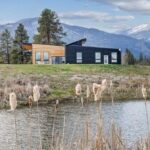BISMARCK, N.D. (AP) — A Native American tribe in North Dakota is embarking on a project to grow lettuce in a massive greenhouse complex that will be one of the largest in the country. This effort will allow the tribe to produce a significant amount of its own food, a vital step after their traditional farming lands were flooded by a federal dam many years ago.
The Mandan, Hidatsa, and Arikara Nation are currently constructing a 3.3-acre greenhouse under the Native Green Grow operation. The first phase of this project is expected to be completed this summer and will focus on growing leafy greens, tomatoes, and strawberries.
Tribal Chairman Mark Fox emphasized the historical significance of the project, stating, “We’re the first farmers of this land. We once played a crucial role in the aboriginal trade system by cultivating crops like corn, beans, squash, and watermelons for thousands of years.”
The tribe is investing approximately $76 million in the initial phase of the greenhouse project, which will also include a warehouse and other facilities near Parshall. The goal is to expand the greenhouse space in the future, making it one of the largest facilities globally.
Notably, the initial greenhouse will cover an area equivalent to seven football fields, showcasing the magnitude of the project.
Due to the flooding caused by the Garrison Dam in the 1950s, the tribe’s fertile land along the Missouri River was submerged. Accessing fresh produce has been a challenge in the remote region of western North Dakota where the tribe is located.
The greenhouse initiative is crucial as it will enable the tribe to provide food for approximately 8,300 individuals on the Fort Berthold Indian Reservation as well as other reservations. The tribe also intends to support food banks in the region and beyond, with plans to export their produce.
In the beginning, the MHA Nation anticipates producing nearly 2 million pounds of food annually, with the goal of increasing this to 12 to 15 million pounds over time. The project is expected to create 30 to 35 jobs in its initial phase.
This endeavor aligns with a national effort to enhance food sovereignty among Native American tribes. Tribes across the United States used federal COVID-19 aid to strengthen their food systems, with examples such as underground greenhouses in South Dakota and meat processing plants in Oklahoma.
The USDA’s Indigenous Food Sovereignty Initiative promotes various programs to support tribal food systems, emphasizing indigenous perspectives on food and agriculture.
The greenhouse project of the MHA Nation is made possible by access to potable water and natural gas resources, with plans to utilize natural gas released in the Bakken oil field to power the greenhouse and produce fertilizer.
Capturing and compressing natural gas will be a key aspect of the project, as the tribe aims to utilize this resource efficiently. Infrastructure development will play a crucial role in achieving this goal.
The Fort Berthold Reservation currently hosts numerous oil wells, generating significant oil production that has contributed to the tribe’s infrastructure development efforts.
Copyright 2024 The Associated Press. All rights reserved. This material may not be published, broadcast, rewritten or redistributed without permission.





